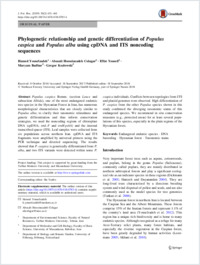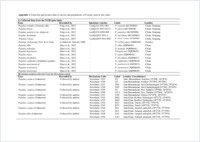Phylogenetic relationship and genetic differentiation of Populus caspica and Populus alba using cpDNA and ITS noncoding sequences
- Yousefzadeh, Hamed Department of Environmental Science, Faculty of Natural Resources, Tarbiat Modares University, Tehran, Iran
- Colagar, Abasalt Hosseinzadeh Department of Molecular and Cell Biology, Faculty of Basic Science, University of Mazandaran, Babolsar, Iran
- Yousefi, Effat Department of Molecular and Cell Biology, Faculty of Basic Science, University of Mazandaran, Babolsar, Iran
- Badbar, Maryam Department of Molecular and Cell Biology, Faculty of Basic Science, University of Mazandaran, Babolsar, Iran
- Kozlowski, Gregor Department of Biology and Botanic Garden, University of Fribourg, Switzerland
-
01.04.2019
Published in:
- Journal of Forestry Research. - 2019, vol. 30, no. 2, p. 451–461
English
Populus caspica Bornm. (section Leuce and subsection Albida), one of the most endangered endemic tree species in the Hyrcanian Forest in Iran, has numerous morphological characteristics that are closely similar to Populus alba; to clarify their taxonomic relatedness and genetic differentiation and thus inform conservation strategies, we used the noncoding regions of chloroplast DNA (cpDNA; trnL-F and trnH-psbA) and the internal transcribed spacer (ITS). Leaf samples were collected from six populations across northern Iran. cpDNA and ITS fragments were amplified by universal primers using the PCR technique and directed sequencing. The results showed that P. caspica is genetically differentiated from P. alba, and two ITS variants were detected within some P. caspica individuals. Conflicts between topologies from ITS and plastid genomes were observed. High differentiation of P. caspica from the other Populus species shown in this study confirmed the diverging taxonomic status of this endangered species. We recommend in situ conservation measures (e.g., protected areas) for at least several populations of this species, especially in the plain regions of the Hyrcanian forest.
- Faculty
- Faculté des sciences et de médecine
- Department
- Département de Biologie
- Language
-
- English
- Classification
- Biological sciences
- License
-
License undefined
- Identifiers
-
- RERO DOC 324275
- DOI 10.1007/s11676-018-0785-4
- Persistent URL
- https://folia.unifr.ch/unifr/documents/307568
Other files
Statistics
Document views: 120
File downloads:
- pdf: 257
- Supplementary material: 154

